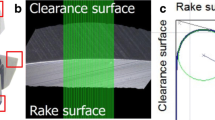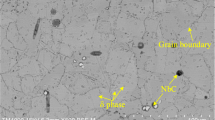Abstract
Wear of cutting tools has a major impact on production cost, quality, and efficiency of the machining processes. Tool wear depends on many parameters including cutting parameters and conditions, tool geometry and materials (coating and base materials), and the workpiece material. This study examines and compares the performance of three state-of-the-art milling tools for high-speed end milling while cutting the same material, stainless steel. The tools have the same base material (tungsten carbide — WC-Co), with different geometrical parameters and coatings (TiAlN and AlCrN). Systematic microscopic analysis and finite element (FE) simulations are used to study mechanisms of damage at the cutting edge. Microscopic analyses show that the flank wear is the most critical damage mechanism at the cutting edge. Having the highest material removal rate, the MT-1 tool experiences cutting edge wear faster among the studied tools with a maximum wear size of 420 μm. This tool ran with a radial depth of cut (ae) equal to 0.96 mm and feed per tooth (fz) of 0.15 mm/tooth, which are maximum values among all the tools. The maximum tool stresses from the FE simulations are obtained equal to 1267, 920, and 1145 MPa for MT-1 (ae of 0.96 mm and fz of 0.15), MT-2 (ae of 0.48 mm and fz of 0.12), and MT-3 (ae of 0.6 mm and fz of 0.15) tools, respectively. This indicates that the radial depth of cut and feed per tooth are the key parameters dictating stresses and degree of wear at the cutting edge.












Similar content being viewed by others
Data availability
The authors confirm that material supporting the findings of this work is available within the article.
References
Kalidass S, Palanisamy P (2014) Experimental investigation on the effect of tool geometry and cutting conditions using tool wear prediction model for end milling process. J Adv Manuf Syst 13(1):41–54. https://doi.org/10.1142/S0219686714500036
Kara F, Karabatak M, Ayyıldız M, Nas E (2020) Effect of machinability, microstructure and hardness of deep cryogenic treatment in hard turning of AISI D2 steel with ceramic cutting. J Mater Res Technol 9(1):969–983. https://doi.org/10.1016/j.jmrt.2019.11.037
Özbek NA, Saruhan H (2020) The effect of vibration and cutting zone temperature on surface roughness and tool wear in eco-friendly MQL turning of AISI D2. J Mat Res Technol 9(3):2762–2772. https://doi.org/10.1016/j.jmrt.2020.01.010
Shixiong W, Zhiyang L, Chengyong W, Suyang L, Wei M (2018) Tool wear of corner continuous milling in deep machining of hardened steel pocket. Int J Adv Manuf Technol 97:1315–1333. https://doi.org/10.1007/s00170-018-1994-x
Reddy NSK, Rao PV (2005) Selection of optimum tool geometry and cutting conditions using a surface roughness prediction model for end milling. Int J Adv Manuf Technol 26:1202–1210. https://doi.org/10.1007/s00170-004-2110-y
Wang CY, Xie YX, Qin Z, Lin HS, Yuan YH, Wang QM (2015) Wear and breakage of TiAlN and TiSiN coated carbide tools during high-speed milling of hardened steel. Wear 336-337:29–42. https://doi.org/10.1016/j.wear.2015.04.018
Palanisamy P, Rajendran I, Shanmugasundaram S (2008) Prediction of tool wear using regression and ANN models in end-milling operation. Int J Adv Manuf Technol 37:29–41. https://doi.org/10.1007/s00170-007-0948-5
Molinari JF, Aghababaei R, Brink T, Frérot L, Milanese E (2018) Adhesive wear mechanisms uncovered by atomistic simulations. Friction 6:245–259. https://doi.org/10.1007/s40544-018-0234-6
Milanese E, Brink T, Aghababaei R, Molinari JF (2019) Emergence of self-affine surfaces during adhesive wear. Nat Commun 10:1116. https://doi.org/10.1038/s41467-019-09127-8
Aghababaei R (2019) On the origins of third-body particle formation during adhesive wear. Wear 426–427:1076–1081. https://doi.org/10.1016/j.wear.2018.12.060
Aghababaei R (2019) Effect of adhesion on material removal during adhesive wear. Phys Rev Materials 3:063604. https://doi.org/10.1103/PhysRevMaterials.3.063604
Trent EM, Wright PK (2000) Metal cutting, 4th edn. Butterworth Heinemann
ISO standards 8688–2:1989(en) Tool-life testing in milling — Part 2: End milling. International Organization for Standards, Geneva
Astakhov VP (2004) The assessment of cutting tool wear. Int J Mach Tools Manuf 44(6):637–647
Bhattacharyya A, Ham I (1969) Analysis of tool wear—part I: theoretical models of flank wear. J Eng Ind 91(3):790–796. https://doi.org/10.1115/1.3591696
AdvantEdge Version 7.6.01 (2020) Third Wave Systems. Minneapolis https://www.thirdwavesys.com/advantedge/
Marusich TD, Ortiz M (1995) Modelling and simulation of high-speed machining. Int J Numer Methods Eng 38(21):3675–3694. https://doi.org/10.1002/nme.1620382108
Marusich T.D. (2001) Effects of friction and cutting speed on cutting force. Proceedings of ASME Congress 2001, Nov. 11-16, 2001. New York, USA.
Marusich T, Usui S, Zamorano L, Marusich K, Oohnishi Y. (2010) Improved titanium machining: modeling and analysis of 5-axis toolpaths via physics-based methods. Proceedings of 4th CIRP International Conference on High Performance Cutting, 24-26 October 2010, Gifu, Japan
Davoudinejad A, Tosello G, Parenti P, Annoni M (2017) 3D finite element simulation of micro end-milling by considering the effect of tool run-out. Micromachines 8:187. https://doi.org/10.3390/mi8060187
Cr-Ni-Mo Austenitic Stainless Steel Technical Brochure. 2018, Columbus Stainless Ltd. https://www.columbus.co.za/downloads/Cr-Ni-Mo_Austenitics.pdf
Vaz M, Owen DRJ, Kalhori V, Lundblad M, Lindgren LE (2007) Modelling and simulation of machining processes. Arch Comput Methods Eng 14:173–204. https://doi.org/10.1007/s11831-007-9005-7
Özel T (2006) The influence of friction models on finite element simulations of machining. Int J Mach Tools Manuf 46:518–530. https://doi.org/10.1016/j.ijmachtools.2005.07.001
Astakhov VP, Outeiro J (2019) Chapter 1: Importance of temperature in metal cutting and its proper measurement/modeling. In: Paulo Davim J (ed) Measurement in machining and tribology. Materials Forming, Machining and Tribology. https://doi.org/10.1007/978-3-030-03822-9_1
Sivaramana V, Sankaranb S, Vijayaraghavan L (2012) The effect of cutting parameters on cutting force during turning multiphase microalloyed steel. Procedia CIRP 4:157–160. https://doi.org/10.1016/j.procir.2012.10.028
Kaynak Y, Gharibi A (2019) The effects of cutting parameters on machining performance of titanium alloy Ti-5553. Adv Mat Process Technol 5(2):317–328. https://doi.org/10.1080/2374068X.2019.1585071
Zhang B, Katinas C, Shin YC (2018) Robust tool wear monitoring using systematic feature selection in turning processes with consideration of uncertainties. J Manuf Sci Eng 140(8):081010 (12 pages). https://doi.org/10.1115/1.4040267
Nouri M, Fussell BK, Ziniti BL, Linder E (2015) Real-time tool wear monitoring in milling using a cutting condition independent method. Int J Mach Tools Manuf 89:1–13. https://doi.org/10.1016/j.ijmachtools.2014.10.011
Nas E, Özbek NA (2020) Optimization of the machining parameters in turning of hardened hot work tool steel using cryogenically treated tools. Surf Rev Lett 27(05):1–14. https://doi.org/10.1142/S0218625X19501774
Kara F, Aslantaş K, Çiçek A (2016) Prediction of cutting temperature in orthogonal machining of AISI316L using artificial neural network. Appl Soft Comput 38:64–74. https://doi.org/10.1016/j.asoc.2015.09.034
Kara F, Aslantaş K, Çiçek (2015) ANN and multiple regression method based modelling of cutting forces in orthogonal machining of AISI 316L stainless steel. Neural Comput Applic 26(1):237–250. https://doi.org/10.1007/s00521-014-1721-y
Shaw MC, Cookson JO (2005) Metal cutting principles, 2nd edn. Oxford University Press, pp 206–207
Kuo HY, Meyer K, Lindle R, Ni J (2012) Estimation of milling tool temperature considering coolant and wear. J Manuf Sci Eng 134(3):031002. https://doi.org/10.1115/1.4005799
Abukhshim NA, Mativenga PT, Sheikh MA (2006) Heat generation and temperature prediction in metal cutting: a review and implications for high speed machining. Int J Mach Tools Manuf 46:782–800. https://doi.org/10.1016/j.ijmachtools.2005.07.024
Acknowledgements
M.M., R.A., and K.B.Ø. acknowledge the financial support from the Innovation Fund Denmark (Innovationsfonden) for the “Cutting Edge” project.
Materials availability
The authors confirm that material supporting the findings of this work is available within the article.
Author information
Authors and Affiliations
Corresponding author
Ethics declarations
Ethics approval and consent to participate
The article follows the guidelines of the Committee on Publication Ethics (COPE) and involves no studies on human or animal subjects.
Consent for publication
Not applicable. The article involves no studies on humans.
Competing interests
The authors declare no competing interests.
Additional information
Publisher’s note
Springer Nature remains neutral with regard to jurisdictional claims in published maps and institutional affiliations.
Appendix – Tool/chip and tool/workpiece interactions
Appendix – Tool/chip and tool/workpiece interactions
Almost all the cutting power is converted to heat and distributed into two areas: primary and secondary deformation/shear zones, as indicated by Shaw and Cookson [32], Kuo et al. [33] and Abukhshim et al. [34]. Additionally, heat generated in the secondary shear zone leads to rise the cutting tool temperature, while a portion of that also is transferred to the chip. Fig. 13 clearly shows how tool interacts with chip/workpiece and corresponding forces and heats generated during the cutting process.
As can be seen in Fig. 13, Heat generated in the secondary shear zone, one heats up the cutting tool (mainly the cutting edge) and the other goes into the chip. The heat flowing into the cutting tool is defined as:
in which α is the portion indicator of heat flows into the tool (typically around 50%) and Qfr is friction power/heat consumed in the rake face and is defined by:
where F is the friction force at tool – chip interface and Vch is the chip velocity. From the force diagram shown in Fig. 13, F can be calculated as:
in which Fc and Ft are main or orthogonal cutting and thrust forces, respectively, and β is the rake angle. Chip velocity can be obtained by adopting the principles of kinematics as follows:
where φs is defined as the shear angle, Vc is defined before as the cutting speed, h is the uncut chip thickness (maximum of feed per tooth fz), and hch is the chip thickness (always becomes larger than the uncut chip thickness).
Rights and permissions
About this article
Cite this article
Malekan, M., Bloch-Jensen, C.D., Zolbin, M.A. et al. Cutting edge wear in high-speed stainless steel end milling. Int J Adv Manuf Technol 114, 2911–2928 (2021). https://doi.org/10.1007/s00170-021-07006-5
Received:
Accepted:
Published:
Issue Date:
DOI: https://doi.org/10.1007/s00170-021-07006-5





